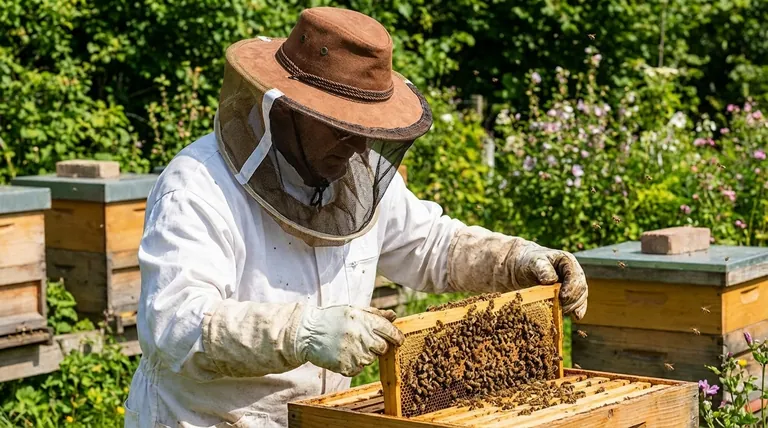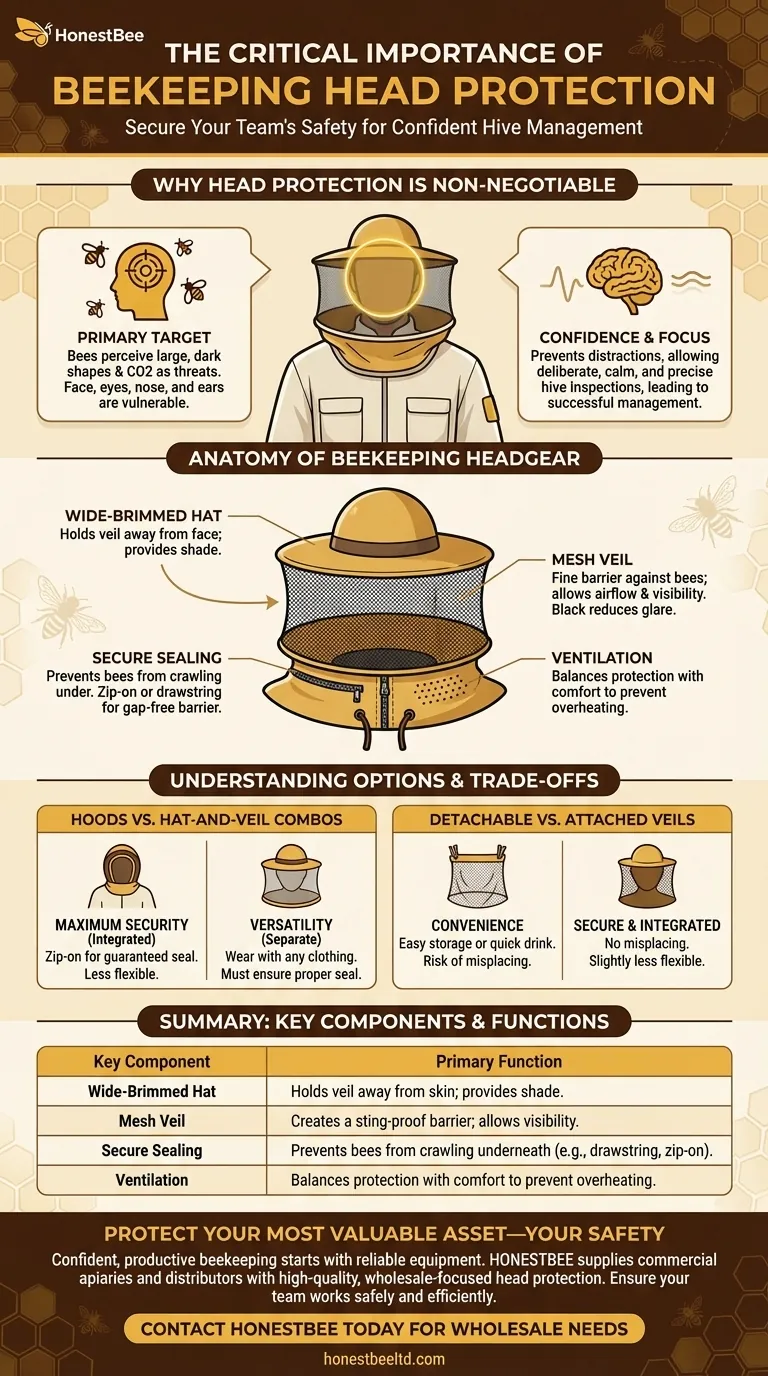For any beekeeper, from the hobbyist to the commercial operator, proper head protection is non-negotiable. Its primary function is to shield your face, neck, and especially your sensitive eyes, nose, and ears from bee stings. A veil creates a simple but critical barrier that prevents bees from reaching these vulnerable areas.
Your head and face are a primary target for defensive bees. Effective head protection is not just about preventing pain; it's about giving you the confidence to work calmly and safely, which is the foundation of successful hive management.

The Critical Role of Facial Protection
Beekeeping headgear is more than just a hat; it is a purpose-built piece of safety equipment designed to counter specific bee behaviors and protect your most vulnerable areas.
Why Bees Target the Head
Bees often perceive large, dark shapes as a threat, similar to a predator like a bear. Your eyes, nose, and mouth can trigger this defensive response. Furthermore, the carbon dioxide you exhale is a known alarm signal for bees, drawing them toward your face.
Shielding Your Most Vulnerable Areas
A sting on the arm is painful, but a sting near the eye, in the nose, or on the ear can be significantly more dangerous and distressing. The primary job of a beekeeping veil is to create an impenetrable zone around your entire head, ensuring these sensitive areas are never exposed.
Maintaining Calm and Focus
Without the constant worry of a bee flying into your face, you can perform hive inspections with greater calm and precision. This confidence allows you to move deliberately and gently, reducing the chance of alarming the colony and leading to a more productive and enjoyable experience.
Anatomy of Beekeeping Headgear
While designs vary, all effective head protection shares a few core components that work together to provide complete safety.
The Wide-Brimmed Hat
The hat serves two purposes. First, it provides shade from the sun. More importantly, its wide brim holds the mesh veil away from your face and neck, ensuring that even if a bee lands on the veil, its stinger cannot reach your skin.
The Veil or Mesh Net
This is the core protective element. The mesh is fine enough to prevent bees from passing through while still allowing for adequate airflow and visibility. Black-colored mesh is generally preferred as it reduces glare and is easier to see through than white or light-colored veils.
Secure Attachment and Sealing
A veil is useless if a bee can crawl under it. Headgear must have a secure way to seal around your neck and shoulders. This is often achieved with a drawstring or by zipping the veil directly onto a beekeeping jacket or suit, creating a gap-free barrier.
Understanding the Options and Trade-offs
Different styles of head protection offer various levels of convenience, integration, and security.
Hoods vs. Hat-and-Veil Combos
A hood, which is often integrated into a jacket or suit, offers maximum security with a wrap-around zipper. A separate hat and veil offers more versatility, allowing you to wear it with any shirt or jacket, but you must be diligent about ensuring it is properly sealed at the neck.
Detachable vs. Attached Veils
Some hats feature veils that can be completely detached, which is convenient for storage or a quick drink. Veils permanently attached to a hat or hood remove the risk of misplacing a component but offer slightly less flexibility.
Ventilation vs. Complete Coverage
While total coverage is paramount, good design also incorporates ventilation to prevent overheating. Some modern suits use ventilated panels, balancing complete protection with comfort during hot weather. The key is ensuring any ventilated area still uses a bee-proof mesh.
Making the Right Choice for Your Goal
Your choice of head protection should align with the type of beekeeping you plan to do.
- If your primary focus is maximum security and frequent inspections: Choose a fully integrated jacket or suit with a zip-on hooded veil for a guaranteed seal.
- If your primary focus is versatility for quick or occasional hive checks: A standalone wide-brimmed hat with an attached veil and a drawstring is a flexible and effective option.
- If your primary focus is starting on a budget: A simple pull-over hood veil can provide basic protection, but pay extra attention to ensure it overlaps and seals completely with your clothing.
Ultimately, investing in quality head protection is an investment in your own safety and ability to be an effective, confident beekeeper.
Summary Table:
| Key Component | Primary Function |
|---|---|
| Wide-Brimmed Hat | Holds veil away from skin; provides shade. |
| Mesh Veil | Creates a sting-proof barrier; allows visibility. |
| Secure Sealing | Prevents bees from crawling underneath (e.g., drawstring, zip-on). |
| Ventilation | Balances protection with comfort to prevent overheating. |
Protect Your Most Valuable Asset—Your Safety.
Confident, productive beekeeping starts with reliable equipment. At HONESTBEE, we supply commercial apiaries and beekeeping equipment distributors with the highest-quality, wholesale-focused head protection and safety gear. Ensure your team works safely and efficiently.
Contact HONESTBEE today to discuss your wholesale needs and secure your essential beekeeping supplies.
Visual Guide

Related Products
- Heavy Duty Cowboy Beekeeper Hat with Visibility Veil Outdoor Professional Beekeeping Protective Gear
- Beekeeper Cowboy Hat and Veil for Beekeeping
- Cotton Beekeeping Suit and Round Hat with Veil Bee Keeper Protective Gear
- Economy Polyester Beekeeping Jacket with Veil and Hat
- Beekeeping Jacket with Hood and Veil for Beekeepers
People Also Ask
- How does the design of the beekeeping hat ensure comfort during extended use? Maximize Comfort for Long Apiary Hours
- How can beekeeping supplies and accessories enhance the hobby? Essential Tools for Safe & Rewarding Beekeeping
- What are the benefits of the lightweight fabric used in the beekeeping hat veil? Enhanced Visibility & Comfort for Hive Work
- What activities is the beekeeping hat suitable for? Beyond the Hive for Ultimate Outdoor Protection
- What is the purpose of a hat and veil in beekeeping? Essential Protection for Head & Face



















